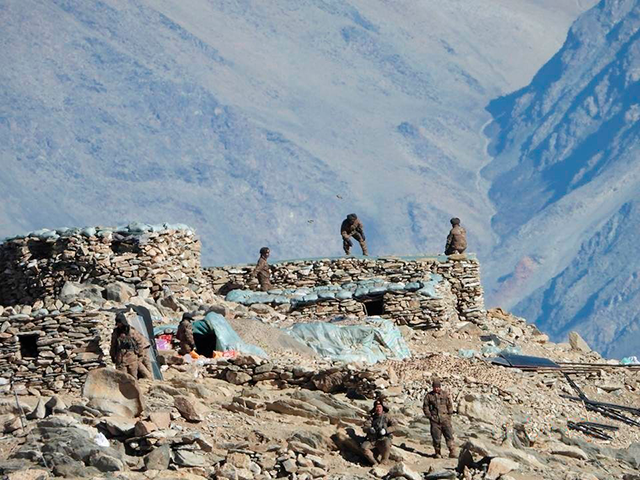The Chinese Defense Ministry revealed the names of four People’s Liberation Army (PLA) soldiers killed in hand-to-hand combat with Indian troops in June 2020 on Friday, claiming these to be the only casualties in an exchange the Indian government said killed dozens of Chinese.
PLA forces and Indian soldiers engaged in the most violent incident between the two states in half a century last year on their mutual border in the Himalayas, formally known as the Line of Actual Control (LAC). According to Indian officials, the nation’s officers found an unexpected group of PLA soldiers establishing camp on territory clearly within Indian sovereign territory in an area known as the Galwan Valley. When confronted, the Chinese soldiers attacked with rudimentary weapons, attempting to stone the Indian soldiers and beating them with sticks wrapped in barbed wire. Indian officials estimated they lost about 20 soldiers and the Chinese suffered double that number of casualties despite the Indian troops being outnumbered. Beijing never issued its own death count or identified any of the troops it lost, stating only that Indian officials were lying.
On Friday, the Chinese Defense Ministry finally admitted to the loss of at least four soldiers in the Galwan Valley standoff. It concurred with India in announcing that 20 Indian soldiers had died.
“Chen Hongjun, Chen Xiangrong, and Xiao Siyuan fought to the last minute and sacrificed their lives. Wang Zhuoran, a fellow soldier, also gave his life to rescue his comrades when crossing the river to support the others,” China’s state-run Global Times revealed on Friday, relaying the information published by the Defense Ministry. The Communist Party also announced it would award the four soldiers posthumously, and a fifth soldier who suffered injuries but survived, with “first-class merit” awards.
In their announcement, Chinese military leaders accused the Indian military of prompting the incident by attacking Chinese soldiers on Chinese land, the opposite of what the Indian military has repeatedly asserted since June. The Global Times also accused the Indian troops, not the Chinese, of using “steel tubes, cudgels and stones” to fight.
“In June 2020, the Indian military violated the previous consensus and trespassed the LAC and built tents. Out of respect to previous agreements and rituals, Qi Fabao, regimental commander of the Chinese military, went to negotiate with a few soldiers,” the Global Times narrated. “However, the Indian military showed no sincerity and had already deployed more soldiers in an attempt to force the Chinese soldiers to concede.”
The Indian military claimed its local military leader, Colonel Santosh Babu, approached the Chinese forces upon finding them illegally present in the Galwan Valley and faced an immediate assault. Babu was among the first identified deaths in the attack, flung off a steep cliff to his death, according to India. Indian reports claimed most of the deaths were attributable to similar throws or falls or to hypothermia, given the low temperatures in the Himalayan heights.
Prior to the incident, Beijing and New Delhi had agreed to ban the use of firearms on their mutual border. The Indian government has since permitted its soldiers to carry firearms in light of the attack,
During her regular press briefing on Friday, Chinese Foreign Ministry spokeswoman Hua Chunying claimed that the discrepancy in casualties between the Indian and Chinese reports was because “the Indian side has repeatedly sensationalized and hyped up this incident with the casualties and distorted the truth to mislead the international public opinion.”
“The Galwan Valley conflict in June last year resulted in casualties on both sides. The responsibility lies entirely with the Indian side,” Hua insisted.
The spokeswoman added that the PLA felt it necessary to make “the truth public” because of Indian “misinformation, but did not explain why it took eight months for China to clarify that it had endured casualties, particularly if it claimed to have suffered fewer of them than the Indian military.
The Global Times, in an editorial, did attempt to explain the delay, claiming that current agreements to remove troops and military assets from the LAC have made it safer for China to admit it had lost soldiers.
“Back to the Galwan Valley clash last year, given the tense situation at that time, avoiding a comparison of casualties was more conducive to the stability of the border situation,” the editorial alleged. “Now that the round of border standoff has ended, we must make public the heroes’ deeds so that all the Chinese people could admire and commemorate them to understand the weight of peace.”
The Global Times insisted that India “suffered heavy losses” in the Galwan Valley clash and boasted, “No one is allowed to infringe on China’s territorial sovereignty and national interests. It’s only wishful thinking if one wants to crash or restrain the PLA.”
The Indian government has yet to respond on-the-record to China’s new claims of casualties. In June 2020, Indian officials promptly offered their assessment of the incident, revealing 20 deaths on the Indian side and an estimated 40 for the PLA.
“The Chinese army possibly suffered more than twice the casualties [of the Indian side],” retired four-star Indian Army General V.K. Singh said at the time, according to the Hindustan Times. Indian news reports at the time estimated that as many as 600 soldiers from both sides were involved in the attack.
Chinese government officials did not admit to any casualties until Friday, but the Global Times described some of the soldiers involved as “martyrs” in an article in September, implying that some had died. The newspaper never elaborated on its use of the term.

COMMENTS
Please let us know if you're having issues with commenting.